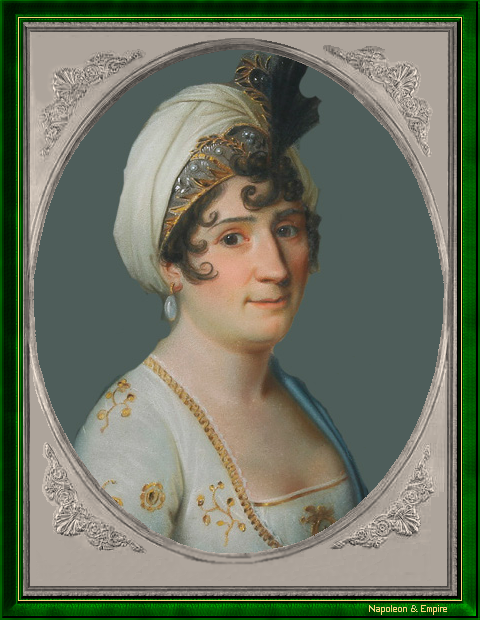Marguerite Pauline Fourès
Pronunciation:

Marguerite Pauline Bellisle was born in Pamiers, in the government of Foix, on March 15, 1778. She was the daughter of Marguerite Pauline Barandon and Henri Jacques Clément Bellisle, a watchmaker. Pauline, a milliner's apprentice in Carcassonne, met her future husband, Jean-Noël Fourès, brother or nephew of her boss and second lieutenant in the 22nd Regiment of Mounted Chasseurs. The two young people were united on January 27, 1798 (8 pluviôse year VI), despite the opposition of the groom's parents.
When her companion embarked for Egypt in May 1798, the "Bellilote" (the young woman's nickname in Carcassonne) didn't hesitate to disguise herself as a "chasseur à cheval" and slip aboard the Lucette, the ship that was taking her there. Once on board, Pauline changed out of her military garb and backed into clothes befitting her gender. The young woman's beauty won her the admiration of the officers of the expeditionary corps, who were somewhat frustrated by the mores and dress habits of the local female population. Napoleon Bonaparte himself was seduced.
He first met the young woman on November 30 or December 1, 1798 at the Egyptian Tivoli. At first, his efforts to win her over seemed in vain. Pauline was known to have formed a model couple with her husband, and had resisted the advances of the 22nd chasseurs' brigade commander, the brilliant Antoine Charles Lasalle.
On December 17, Lieutenant Fourès (he had been promoted on October 18, so for perfectly honorable reasons) was opportunely assigned to carry dispatches to Paris. Whatever the alleged reasons - risk or urgency of the mission - he was formally forbidden to bring his wife with him. Shortly afterwards, at a dinner party, Pauline became General Bonaparte's mistress. Bonaparte soon installed her in a house on the Place d'Ezbékieh, close to Elfi Bey's palace, where he himself lived. The two lovers seem very much in love and are openly affectionate.
It is possible that Napoleon was considering repudiating Joséphine, whose infidelities he had just learned of from Jean-Andoche Junot, and replacing her with Pauline. Perhaps the birth of a child would convince him, but despite their best efforts, the lovers were unable to procreate. The first doubts about his ability to father a child began to creep into Napoleon's mind, especially as his partner proclaimed: Ma foi, c'est pas ma faute. (Well, it's not my fault)
.
Then, unexpectedly, Lieutenant Fourès reappeared. The English, having intercepted Jean-Noël's ship and probably knowing better than he did the state of his matrimonial affairs, had the mischief to send him back to Egypt, once they'd established the insignificance of the dispatches he was carrying.
Back in Cairo on January 8, 1799, Fourès was informed by his colleagues of his wife's behavior. Jealous and hot-tempered, he immediately rushed to her home and, mad with rage, let himself be beaten before being thrown out into the street by the servants.
A few days later, Pauline asked for the marriage to be dissolved. This was naturally granted within hours by Antoine Léger Sartelon, Cairo's commissioner. Pauline almost officially became Bonaparte's mistress.
Eugène de Beauharnais was upset, but he was alone. The whole army approved of their leader's choice, for the young woman, in addition to her beauty, had shown courage in a number of critical circumstances: the enemy's attack on her fleet during the ascent of the Nile from Alexandria, and the revolt in Cairo on October 21, 1798. Pauline, who often appeared in magnificent uniforms, was nicknamed "La Générale" or "Clioupatre" by her lover and her soldiers. The Egyptians, meanwhile, called her "the lady of the Great Sultan".
In February 1799, when Bonaparte set off for Syria, Pauline was not on the trip. She was waiting for him in Cairo, where Napoleon immediately renewed his relationship with her after the expedition's return. However, he abandoned her rather ingloriously in August, leaving her to believe that he was only away for an inspection in the Nile delta, as he headed back to France.
General Jean-Baptiste Kléber succeeded Bonaparte in the young woman's good graces, as well as in command of the army. But the romance was short-lived, and Pauline left Cairo on October 15, before embarking for France on October 25, on the same ship as Andoche Junot, the America.
She arrived in Marseille eight days later, but had to undergo the quarantine imposed on all ordinary travelers returning from Egypt, where the plague was raging. On leaving the lazaretto, she rushed to Paris, but Napoleon, now First Consul, refused to receive her to avoid any risk of scandal. He did, however, offer her a private hotel and a host of gifts. The two former lovers met only once more, at a ball in 1811; the next day, the Emperor sent her money, but not a word.
The rest of Pauline's life was hardly less romantic.
In 1800 or 1801, Jean-Paul Fourès reappeared, contesting the divorce granted in Egypt. To put an end to these quarrels, on October 11, 1801, on the advice of Geraud-Christophe Duroc commissioned by Napoleon, La Bellilote married Chevalier (or Count) Pierre Henri de Ranchoux, a retired infantry officer and former emigrant.
As a wedding present, he received from the head of state the post of vice-consul in Santander. Later, in 1810, he became French consul in Gothenburg, Sweden. His wife did not follow him to this northern country, preferring Parisian life. This led to her being watched by Joseph Fouché's police and even exiled for a time to Blois, during the French invasion of Russia.
On her husband's return, she refused to resume her life together. He retaliated by having her relegated to Craponne (Haute-Loire) and filing for divorce. Pauline, bereft of income and having saved nothing during her time in Paris, was ruined. To survive, she wrote a novel, Lord Wentworth, which met with some success.
But her charm still worked. In the spring of 1816, she remarried Jean Baptiste Bellard, an ex-captain of the Guard. The couple settled in Rio de Janeiro, Brazil. There, he made his fortune in the exotic wood trade.
In 1837, Pauline returned to France, settling in Paris. The following year, she separated from her third husband and led a quiet existence, although considered eccentric by her neighbors. She shares her apartment with many free-living animals, monkeys and birds, takes her dog to church and smokes outside her window. To keep busy, she painted (a self-portrait remains), collected paintings (which she bequeathed to the town of Blois) and continued to write novels and short stories.
She died on March 18, 1869, at the respectable age of ninety-one, having burned the letters of General Bonaparte, for whom she had long felt nothing but indifference, after going through a period of violent hostility. She died without issue, her three marriages having been sterile.
Pauline Fourès, known as La Bellilote, is buried in Paris, in the Père-Lachaise cemetery, 26th division .
"Pauline Fourès", 19th century painting.
